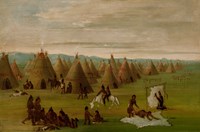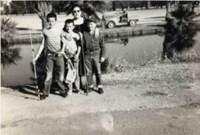- Lesson Plan (49)
- Distance Learning (15)
- Field Trips (10)
- Traveling Trunk (7)
- Student Activities (4)
- Guest Speakers (1)
- Other Education Materials (1)
- Teacher Reference Materials (1)
- Homestead National Historical Park (6)
- Acadia National Park (5)
- Bent's Old Fort National Historic Site (5)
- Glacier National Park (4)
- Santa Monica Mountains National Recreation Area (3)
- Sitka National Historical Park (3)
- Tumacácori National Historical Park (3)
- Denali National Park & Preserve (2)
- Florissant Fossil Beds National Monument (2)
- Show More ...
- Social Studies (63)
- Science (32)
- Literacy and Language Arts (25)
- Math (3)
Showing 86 results for Indigenous sovereignty ...
- Type: Lesson Plan
- Grade Levels: Upper Elementary: Third Grade through Fifth Grade
So You Wanna Be a Paleontologist?
- Type: Lesson Plan
- Grade Levels: Upper Elementary: Third Grade through Fifth Grade

Students will become familiarized with fossils that have been uncovered in Florissant Fossil Beds from the Eocene and Quaternary. They will select a certain extinct species and make a sketch on a Popsicle stick canvas. After shuffling their Popsicle stick fossil, they will then hide the sticks around a room and have someone else find and "excavate" the Popsicle stick fossil and attempt to put it back together. Best done with a partner to exchange fossils to find and put together.
So You Wanna Be a Paleobotanist?
- Type: Lesson Plan
- Grade Levels: Upper Elementary: Third Grade through Fifth Grade

Students will re-create scientific studies done by paleobotanists analyzing data from fossil plants found at Florissant Fossil Beds to draw conclusions about the paleoclimate 34 million years ago. In this activity, students will identify fossil plant species by their leaves, review data on the growing conditions of their nearest modern plant relatives, and compare as many species as possible to determine the range of temperature and precipitation that the fossil plant community can live in.
So you want to be an American President
- Type: Lesson Plan
- Grade Levels: Upper Elementary: Third Grade through Fifth Grade
"What's So Special?" Environment: 4-6 Grade
- Type: Lesson Plan
- Grade Levels: Upper Elementary: Third Grade through Fifth Grade

Students will draw a favorite plant, animal, or activity common to the Everglades environment and explain, in writing, the reason they chose it. This will help students recognize and identify one valuable aspect of a national park’s environment, and draw conclusions as to why they value that aspect of the environment.
Shifting Sovereignty: How the United States Took Control of Alaska
- Type: Distance Learning
- Grade Levels: Middle School: Sixth Grade through Eighth Grade

The transfer of Alaska from the hands of Imperial Russia to the United States represents a major turning point in the history of Alaska, the United States, and Russia. Given that the transfer ceremony took place in Sitka, in what was then the Russian city of New Archangel, our park is uniquely suited to educate students about the growth and change of Russian America and the myriad of social, economic, and military changes that occurred in both the Unite States and Russia.
Flags and National Identity
- Type: Lesson Plan
- Grade Levels: Upper Elementary: Third Grade through Fifth Grade
The records Lewis Garrard kept during his ten-month journey along the Santa Fe Trail provide an outsider's view into intercultural interactions in the 1840s. This lesson features how national identity and sovereignty have been communicated through dress, color, and symbols in early American history as well as today.
Soft Gold: The History of Russians in Alaska
- Type: Distance Learning
- Grade Levels: Upper Elementary: Third Grade through Fifth Grade

How and why Russians came to and settled in Alaska is not only important for understanding Alaskan history, but also contains themes necessary for students to understand important historical ideas/concepts like trade, colonialism, and the rights of indigenous peoples. In addition, the efforts of Russian and other non-Alaskan native fur hunters had severe scientific, environmental, and cultural effects on this region and its indigenous peoples.
American Indians and the Great Plains
- Type: Field Trips
- Grade Levels: Lower Elementary: Pre-Kindergarten through Second Grade

American Indians have lived in North America for thousands of years. All of the lands that make up the United States today were exclusively Indigenous lands long before Europeans first arrived about 500 years ago. The growth of the United States through westward expansion challenged traditional ways of life for many Indigenous tribes during the 1800s as more settlers crossed the Mississippi River for a new life in the West.
- Type: Lesson Plan
- Grade Levels: Upper Elementary: Third Grade through Fifth Grade

The spotted salamander is indigenous to the areas surrounding the Natchez Trace Parkway. When the salamanders breed, they usually return to the same vernal pond from which they hatched. Unfortunately for some populations, this presents a hazard as the Natchez Trace Parkway is in between their forest habitat and the vernal breeding ponds.
Exploring Conflict and Colonization: The Sitka Battles of 1802 and 1804
- Type: Distance Learning
- Grade Levels: High School: Ninth Grade through Twelfth Grade

For nearly 70 years, the Russian American company oversaw a colonial empire from their seat of power in the Russian colony of New Archangel- but founding a colony on the native land of the Tlingit people was no simple task. In this robust, place-based distance learning program, come the Battles of 1802 and 1804 that occurred right here in Sitka, while discussing important historical themes like conflict, colonization, and the rights of indigenous peoples.
Border Conflict 7th & 8th Grade
Salem, Slavery, and the Sacred Cod
Hope Inspired Community
Beaver Lodge Family
Frederick Douglass and the Power of Literacy
The Liberty Bell as a Modern Symbol, grades 3-5
Facing Adversity
Taking a Stand Against Slavery: Stories from Frederick Douglass. Grade 4
National Park Legacy - Wildlife in Cities Grades K - 2
- Type: Lesson Plan
- Grade Levels: Lower Elementary: Pre-Kindergarten through Second Grade

Coexisting with wildlife requires that actions be taken to reduce conflicts and minimize impacts from human activity so that a healthy appreciation of wildlife can be fostered. Specifically addressed in this lesson are efforts SMMNRA is making to encourage residents to clean up unintentional food resources such as pet food, and secure trash cans so that unwanted wildlife do not seek food on personal property.










